
Fingerspelling
Encyclopedia
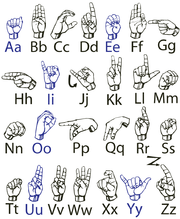
Letter (alphabet)
A letter is a grapheme in an alphabetic system of writing, such as the Greek alphabet and its descendants. Letters compose phonemes and each phoneme represents a phone in the spoken form of the language....
s of a writing system
Writing system
A writing system is a symbolic system used to represent elements or statements expressible in language.-General properties:Writing systems are distinguished from other possible symbolic communication systems in that the reader must usually understand something of the associated spoken language to...
, and sometimes numeral system
Numeral system
A numeral system is a writing system for expressing numbers, that is a mathematical notation for representing numbers of a given set, using graphemes or symbols in a consistent manner....
s, using only the hands. These manual alphabets (also known as finger alphabets or hand alphabets), have often been used in deaf education
Deaf education
Deaf education is the academic discipline concerned the education of students with various hearing capabilities in a way that addresses the students' individual differences and needs.Deaf education also includes the study of:* Special education...
, and have subsequently been adopted as a distinct part of a number of sign language
Sign language
A sign language is a language which, instead of acoustically conveyed sound patterns, uses visually transmitted sign patterns to convey meaning—simultaneously combining hand shapes, orientation and movement of the hands, arms or body, and facial expressions to fluidly express a speaker's...
s around the world. Historically, manual alphabets have had a number of additional applications — including use as cipher
Cipher
In cryptography, a cipher is an algorithm for performing encryption or decryption — a series of well-defined steps that can be followed as a procedure. An alternative, less common term is encipherment. In non-technical usage, a “cipher” is the same thing as a “code”; however, the concepts...
s, as mnemonic
Mnemonic
A mnemonic , or mnemonic device, is any learning technique that aids memory. To improve long term memory, mnemonic systems are used to make memorization easier. Commonly encountered mnemonics are often verbal, such as a very short poem or a special word used to help a person remember something,...
s, and in silent religious settings.
Forms of manual alphabets
As with other forms of manual communicationManual communication
Manual communication systems use articulation of the hands to mediate a message between persons. Being expressed manually, they are received visually, and sometimes tactually...
, Fingerspelling can be comprehended visually or tactually
Tactile signing
Tactile signing is a common means of communication used by people with both a sight and hearing impairment , which is based on a standard system of Deaf manual signs.-Kinds of tactile signing:...
. The simplest visual form of fingerspelling is tracing the shape of letters in the air, or tactually, tracing letters on the hand. Fingerspelling can be one-handed such as in American Sign Language
American Sign Language
American Sign Language, or ASL, for a time also called Ameslan, is the dominant sign language of Deaf Americans, including deaf communities in the United States, in the English-speaking parts of Canada, and in some regions of Mexico...
, French Sign Language
French Sign Language
French Sign Language is the sign language of the deaf in the nation of France. According to Ethnologue, it has 50,000 to 100,000 native signers....
and Irish Sign Language
Irish Sign Language
Irish Sign Language is the sign language of Ireland, used primarily in the Republic of Ireland. It is also used in Northern Ireland, though British Sign Language is also used. Irish Sign Language is more closely related to French Sign Language than to British Sign Language, which was first used...
, or it can be two-handed such as in British Sign Language
British Sign Language
British Sign Language is the sign language used in the United Kingdom , and is the first or preferred language of some deaf people in the UK; there are 125,000 deaf adults in the UK who use BSL plus an estimated 20,000 children. The language makes use of space and involves movement of the hands,...
.
One-handed
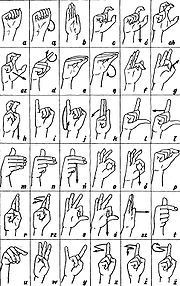
Latin alphabet
The Latin alphabet, also called the Roman alphabet, is the most recognized alphabet used in the world today. It evolved from a western variety of the Greek alphabet called the Cumaean alphabet, which was adopted and modified by the Etruscans who ruled early Rome...
in the modern world. The more common of the two is mostly produced on one hand, and can be traced back to alphabetic signs used in Europe from at least the early 15th century. The alphabet, first described completely by Spanish monks, was adopted by the Abbé de l'Épée
Charles-Michel de l'Épée
Abbé Charles-Michel de l'Épée was a philanthropic educator of 18th-century France who has become known as the "Father of the Deaf".-Overview:...
's deaf school in Paris in the 18th century, and was then spread to deaf communities around the world in the 19th and 20th centuries via educators who had learned it in Paris. Over time, variations have emerged, brought about by natural phonetic changes
Sound change
Sound change includes any processes of language change that affect pronunciation or sound system structures...
that occur over time, adaptions for local written forms with special characters or diacritic
Diacritic
A diacritic is a glyph added to a letter, or basic glyph. The term derives from the Greek διακριτικός . Diacritic is both an adjective and a noun, whereas diacritical is only an adjective. Some diacritical marks, such as the acute and grave are often called accents...
s (which are sometimes represented with the other hand), and avoidance of handshapes that are considered obscene in some cultures. Modern descendants include the American manual alphabet and the International manual alphabet.
Two-handed
Two-handed manual alphabets are used by a number of deaf communities, including England, Scotland, and Wales and countries of the former YugoslaviaYugoslavia
Yugoslavia refers to three political entities that existed successively on the western part of the Balkans during most of the 20th century....
and Turkish Sign Language
Turkish Sign Language
Turkish Sign Language is the language used by the deaf community in Turkey. As with other sign languages, TİD has a unique grammar that is different from the spoken languages used in the region....
. Some of the letters are represented by iconic shapes, such as b, c, d, k, and, in British Sign Language and the BANZSL
BANZSL
BANZSL, or British, Australian and New Zealand Sign Language, is the language of which British Sign Language , Auslan and New Zealand Sign Language may be considered dialects...
group of languages, the vowels a, e, i, o, and u, are represented by pointing to the fingertips.
Letters are formed by a dominant hand, which is on top of or alongside the other hand at the point of contact, and a subordinate hand, which uses either the same or a simpler handshape as the dominant hand. Either the left or right hand can be dominant. In a modified tactile form used by deafblind people, the signer's hand acts as the dominant hand, and the receiver's hand becomes the subordinate hand.
Some signs, such as the sign commonly used for the letter C, may be one-handed.
Other alphabets
Manual alphabets based on the Arabic alphabet, the Ethiopian syllabary and the Korean hangul syllabary-alphabet use handshapes that are more or less iconic representations of the characters in the writing system. Some manual representations of non-Roman scripts such as Chinese, Japanese, Devanagari, Hebrew, Greek, Thai and Russian alphabets are based to some extent on the one-handed Latin alphabet described above.Fingerspelling in sign languages
Fingerspelling has been introduced into certain sign languages by educators, and as such has some structural properties that are unlike the visually motivated and multi-layered signs that are typical in deaf sign languages. In many ways fingerspelling serves as a bridge between the sign language and the spoken language that surrounds it.Fingerspelling is used in different sign languages and register
Register (linguistics)
In linguistics, a register is a variety of a language used for a particular purpose or in a particular social setting. For example, when speaking in a formal setting an English speaker may be more likely to adhere more closely to prescribed grammar, pronounce words ending in -ing with a velar nasal...
s for different purposes. It may used be to represent words from a spoken language which have no sign equivalent, or for emphasis, clarification, or when teaching or learning a sign language.
In American Sign Language
American Sign Language
American Sign Language, or ASL, for a time also called Ameslan, is the dominant sign language of Deaf Americans, including deaf communities in the United States, in the English-speaking parts of Canada, and in some regions of Mexico...
(ASL), more lexical items are fingerspelled in casual conversation than in formal or narrative signing. Different sign language "speech communities
Speech community
Speech community is a group of people who share a set of norms and expectations regarding the use of language. Speech communities can be members of a profession with a specialized jargon, distinct social groups like high school students or hip hop fans , or even tight-knit groups like families and...
" use fingerspelling to a greater or lesser degree. At the high end of the scale, fingerspelling makes up about 8.7% of casual signing in ASL, and 10% of casual signing in Auslan
Auslan
Auslan is the sign language of the Australian deaf community. The term Auslan is an acronym of "Australian sign language", coined by Trevor Johnston in the early 1980s, although the language itself is much older...
. The proportion is higher in older signers, suggesting that the use of fingerspelling has diminished over time. Across the Tasman Sea
Tasman Sea
The Tasman Sea is the large body of water between Australia and New Zealand, approximately across. It extends 2,800 km from north to south. It is a south-western segment of the South Pacific Ocean. The sea was named after the Dutch explorer Abel Janszoon Tasman, the first recorded European...
, only 2.5% of the corpus
Corpus linguistics
Corpus linguistics is the study of language as expressed in samples or "real world" text. This method represents a digestive approach to deriving a set of abstract rules by which a natural language is governed or else relates to another language. Originally done by hand, corpora are now largely...
of New Zealand Sign Language
New Zealand Sign Language
New Zealand Sign Language or NZSL is the main language of the Deaf community in New Zealand. It became an official language of New Zealand in April 2006, alongside Te Reo Māori....
was found to be fingerspelling. Fingerspelling has only become a part of NZSL since the 1980s; prior to that, words could be spelled or initialised by tracing letters in the air. Fingerspelling does not seem to be used much in the sign languages of Eastern Europe, except in schools, and Italian Sign Language
Italian Sign Language
Italian Sign Language or ISL is the visual language employed by deaf people in Italy. Deep analysis of it began in the 1980s, along the lines of William Stokoe's research on American Sign Language in the 1960s. Until recently, most of the studies about Italian Sign Language have dealt with its...
is also said to use very little fingerspelling, and mainly for foreign words. Sign languages that make no use of fingerspelling at all include Kata Kolok
Kata Kolok
Kata Kolok , also known as Benkala Sign Language and Balinese Sign Language, is a sign language of the village of Benkala in northern Bali, Indonesia, that has had an extraordinarily high rate of deafness for several generations...
and Ban Khor Sign Language
Ban Khor Sign Language
Ban Khor Sign Language is a sign language used by about 1,000 people of a rice-farming community in the villages of Ban Khor and Plaa Pag in a remote area of Isan . Ban Khor proper and Plaa Pag are dialects, with some 80% of signs in common. It developed about 60–80 years ago due to a high number...
.
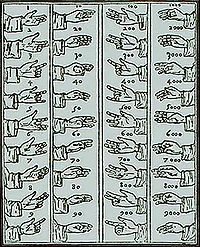
British Sign Language
British Sign Language is the sign language used in the United Kingdom , and is the first or preferred language of some deaf people in the UK; there are 125,000 deaf adults in the UK who use BSL plus an estimated 20,000 children. The language makes use of space and involves movement of the hands,...
(BSL) is often rapid so that the individual letters become difficult to distinguish, and the word is grasped from the overall hand movement. Most of the letters of the BSL alphabet are produced with two hands, but when one hand is occupied, the dominant hand may fingerspell onto an "imaginary" subordinate hand, and the word can be recognised by the movement. As with written words, the first and last letters and the length of the word are the most significant factors for recognition.
When persons fluent in sign language read fingerspelling, they do not usually look at the signer's hand(s), but maintain eye contact and look at the face of the signer as is normal for sign language. People who are learning fingerspelling often find it impossible to understand it using just their peripheral vision
Peripheral vision
Peripheral vision is a part of vision that occurs outside the very center of gaze. There is a broad set of non-central points in the field of view that is included in the notion of peripheral vision...
and must look directly at the hand of someone who is fingerspelling. Often, they must also ask the signer to fingerspell slowly. It frequently takes years of expressive and receptive practice to become skilled with fingerspelling.
History
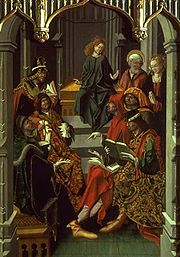
Gematria
Gematria or gimatria is a system of assigning numerical value to a word or phrase, in the belief that words or phrases with identical numerical values bear some relation to each other, or bear some relation to the number itself as it may apply to a person's age, the calendar year, or the like...
, was also common, and it is possible that the two practices were combined to produce a finger calculus alphabet. The earliest known manual alphabet, described by the Benedictine
Benedictine
Benedictine refers to the spirituality and consecrated life in accordance with the Rule of St Benedict, written by Benedict of Nursia in the sixth century for the cenobitic communities he founded in central Italy. The most notable of these is Monte Cassino, the first monastery founded by Benedict...
monk Bede
Bede
Bede , also referred to as Saint Bede or the Venerable Bede , was a monk at the Northumbrian monastery of Saint Peter at Monkwearmouth, today part of Sunderland, England, and of its companion monastery, Saint Paul's, in modern Jarrow , both in the Kingdom of Northumbria...
in 8th century Northumbria
Northumbria
Northumbria was a medieval kingdom of the Angles, in what is now Northern England and South-East Scotland, becoming subsequently an earldom in a united Anglo-Saxon kingdom of England. The name reflects the approximate southern limit to the kingdom's territory, the Humber Estuary.Northumbria was...
, did just that. While the usual purpose of the Latin and Greek finger alphabets described by Bede is unknown, they were unlikely to have been used by deaf people for communication — even though Bede lost his own hearing later in life. Historian Lois Bragg concludes that these alphabets were "only a bookish game."
Beginning with R. A. S. Macalister
Robert Alexander Stewart Macalister
Robert Alexander Stewart Macalister was an Irish archaeologist.Macalister was born in Dublin, Ireland and studied at Cambridge University. Although his earliest interest was in the archaeology of Ireland, he soon developed a strong interest in biblical archaeology. Along with Frederick J...
in 1938, several writers have speculated that the 5th century Irish Ogham
Ogham
Ogham is an Early Medieval alphabet used primarily to write the Old Irish language, and occasionally the Brythonic language. Ogham is sometimes called the "Celtic Tree Alphabet", based on a High Medieval Bríatharogam tradition ascribing names of trees to the individual letters.There are roughly...
script, with its quinary
Quinary
Quinary is a numeral system with five as the base. A possible origination of a quinary system is that there are five fingers on either hand. The base five is stated from 0-4...
alphabet system, was derived from a finger alphabet that predates even Bede.
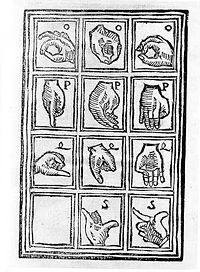
Manual communication
Manual communication systems use articulation of the hands to mediate a message between persons. Being expressed manually, they are received visually, and sometimes tactually...
, including alphabetic gestures, for a number of reasons: communication among the monastery while observing vows of silence
Vow of silence
A vow of silence is a religious vow, usually taken in a monastic context, to maintain silence. Known as Mauna in Hinduism, Jainism, and Buddhism, the practice is integral to Christian and Islamic traditions as well...
, administering to the ill, and as mnemonic
Mnemonic
A mnemonic , or mnemonic device, is any learning technique that aids memory. To improve long term memory, mnemonic systems are used to make memorization easier. Commonly encountered mnemonics are often verbal, such as a very short poem or a special word used to help a person remember something,...
devices. They also may have been used as cipher
Cipher
In cryptography, a cipher is an algorithm for performing encryption or decryption — a series of well-defined steps that can be followed as a procedure. An alternative, less common term is encipherment. In non-technical usage, a “cipher” is the same thing as a “code”; however, the concepts...
s for discreet or secret communication. Clear antecedents of many of the manual alphabets in use today can be seen from the 16th century in books published by friars in Spain and Italy. From the same time, monks such as the Benedictine Fray
Friar
A friar is a member of one of the mendicant orders.-Friars and monks:...
Pedro Ponce de León
Pedro Ponce de León
Fray Pedro Ponce de Leon was a Spanish Benedictine monk who is often credited as being "the first teacher for the deaf".Pedro Ponce de Leon established a school for the deaf at the San Salvador Monastery in Madrid. His students were almost all children of wealthy aristocrats who could afford...
began tutoring deaf children of wealthy patrons — in some places, literacy was a requirement for legal recognition as an heir — and the manual alphabets found a new purpose. They were originally part of the earliest known Mouth Hand Systems. The first book on deaf education, published in 1620 by Juan Pablo Bonet
Juan Pablo Bonet
Juan Pablo Bonet was a Spanish priest and pioneer of education for the deaf. He published the first book on deaf education in 1620 in Madrid....
in Madrid, included a detailed account of the use of a manual alphabet to teach deaf students to read and speak.
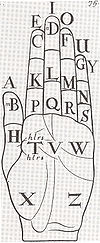
John Bulwer
John Bulwer was an English physician and early Baconian natural philosopher who wrote five works exploring the Body and human communication, particularly by gesture....
described "Master Babington", a deaf man proficient in the use of a manual alphabet, "contryved on the joynts of his fingers", whose wife could converse with him easily, even in the dark through the use of tactile signing
Tactile signing
Tactile signing is a common means of communication used by people with both a sight and hearing impairment , which is based on a standard system of Deaf manual signs.-Kinds of tactile signing:...
. In 1680, George Dalgarno
George Dalgarno
George Dalgarno was a Scottish intellectual interested in linguistic problems. Originally from Aberdeen, he later worked as a schoolteacher in Oxford in collaboration with John Wilkins, although the two parted company intellectually in 1659.-Works:...
published Didascalocophus, or, The deaf and dumb mans tutor, in which he presented his own method of deaf education, including an "arthrological" alphabet, where letters are indicated by pointing to different joints of the fingers and palm of the left hand. Arthrological systems had been in use by hearing people for some time; some have speculated that they can be traced to early Ogham manual alphabets. The vowel
Vowel
In phonetics, a vowel is a sound in spoken language, such as English ah! or oh! , pronounced with an open vocal tract so that there is no build-up of air pressure at any point above the glottis. This contrasts with consonants, such as English sh! , where there is a constriction or closure at some...
s of this alphabet have survived in the contemporary alphabets used in British Sign Language
British Sign Language
British Sign Language is the sign language used in the United Kingdom , and is the first or preferred language of some deaf people in the UK; there are 125,000 deaf adults in the UK who use BSL plus an estimated 20,000 children. The language makes use of space and involves movement of the hands,...
, Auslan and New Zealand Sign Language. The earliest known printed pictures of consonants of the modern two-handed alphabet appeared in 1698 with Digiti Lingua, a pamphlet by an anonymous author who was himself unable to speak. He suggested that the manual alphabet could also be used by mutes, for silence and secrecy, or purely for entertainment. Nine of its letters can be traced to earlier alphabets, and 17 letters of the modern two-handed alphabet can be found among the two sets of 26 handshapes depicted.
Charles de La Fin published a book in 1692 describing an alphabetic system where pointing to a body part represented the first letter of the part (e.g. Brow=B), and vowels were located on the fingertips as with the other British systems. He described codes for both English and Latin.
By 1720, the British manual alphabet had found more or less its present form. Descendants of this alphabet have been used by deaf communities (or at least in classrooms) in former British colonies India, Australia, New Zealand, Uganda and South Africa, as well as the republics and provinces of the former Yugoslavia, Grand Cayman Island in the Caribbean, Indonesia, Norway, Germany and the USA.
See also
- Catalonian manual alphabetCatalonian manual alphabetThe Catalonian manual alphabet is used in Catalan Sign Language. It is one of the oldest manual alphabets still in use....
- Chilean manual alphabetChilean manual alphabetThe Chilean manual alphabet is used by the Chilean Deaf community to sign Spanish words, and is incorporated into Chilean Sign Language. It is a one-handed alphabet, similar enough to the American manual alphabet for the two to be mutually intelligible, except for the letters Q , T , S and X , U...
- Cued SpeechCued speechCued Speech is a system of communication used with and among deaf or hard of hearing people. It is a phonemic-based system which makes traditionally spoken languages accessible by using a small number of handshapes in different locations near the mouth , as a supplement to lipreading...
- French manual alphabetFrench manual alphabetThe French manual alphabet is an alphabet used for French Sign Language, both to distinguish FSL words and to sign French words in FSL.The alphabet has the following letters:...
- Initialized signInitialized signIn sign language, an initialized sign is a word that is signed with a handshape that corresponds to the fingerspelling of the corresponding word in the locally dominant oral language, usually the initial letter of that word. In some cases, this is due to the local oral language having more than one...
- Irish manual alphabetIrish manual alphabetThe Irish manual alphabet is the manual alphabet used in Irish Sign Language. Compared to other manual alphabets based on the Latin alphabet, it has unusual forms for the letters G, H, K, L, P, and Q.Irish manual alphabet...
- Japanese manual syllabary
- Korean manual alphabetKorean manual alphabetThe Korean manual alphabet is used by the Deaf in South Korea who speak Korean Sign Language. It is a one-handed alphabet that mimics the shapes of the letters in hangul, and is used when signing Korean as well as being integrated into KSL.-Consonants:...
- Polish manual alphabetPolish manual alphabetThe Polish manual alphabet is a single-handed manual alphabet used in Polish Sign Language....
- Russian manual alphabetRussian Manual AlphabetThe Russian Manual Alphabet is used for fingerspelling in Russian sign language. The alphabet consists of Cyrillic letters, the same used in Russian and other languages....
- Sign nameSign nameIn Deaf culture and sign language, a sign name is a special sign that is used to uniquely identify a person, just like a name. There are some special cultural rules around sign names; for example, they must be agreed upon by you and people in the Deaf community...
- Spanish manual alphabetSpanish manual alphabetAn early representation of the Spanish manual alphabet, engraved by Francisco de Paula Martí y Mora and published in 1815. Of an edition of 300, the only surviving copy is in the Biblioteca de Catalunya in Barcelona....
- Two-handed manual alphabetTwo-handed manual alphabetSeveral manual alphabets in use around the world employ two hands for some or all of the letters.- BANZSL alphabet :This alphabet is used in the BANZSL group of sign languages. It has been used in British Sign Language and Auslan since at least the 19th century, and in New Zealand Sign Language...
External links
- ASL Fingerspelling Resource Site Free online fingerspelling lessons, quizzes, and activities.
- Fingerspell Flashcards Practice ASL, German and Swiss German alphabets online.
Historic texts
- Bonet, Juan Pablo (1620). Reducción de las letras y arte para enseñar a hablar a los mudos. Scan from Biblioteca Histórica de la Universidad de Sevilla.
- Dalgarno, George (1834). Didascalocophus, Or the Deaf and Dumb Man's Tutor in The Works of George Dalgarno of Aberdeen (Maitland Club publications 29) pp. 110–160.
- Rossellius, Cosmas (1579). Thesaurus Artificiosae Memoriae p. 101-105.
- Wilkins, John (1641) Mercvry, or, the Secret and Swift Messenger
- de Yebra, Melchor (1593) Refugium Infirmorum (Refuge of the Sick}

